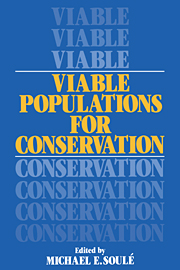Book contents
-
Frontmatter
-
Contents
-
List of contributors
-
Preface
- 1
Introduction
- 2
The demography of chance extinction
- 3
Extinction models and mammalian persistence
- 4
Minimum viable population size in the presence of catastrophes
- 5
Minimum viable populations: coping with uncertainty
- 6
Effective population size, genetic variation, and their use in population management
- 7
Spatial structure and population vulnerability
- 8
Managing critically endangered species: the Sumatran rhino as a case study
- 9
The role of interagency cooperation in managing for viable populations
- 10
Where do we go from here?
-
Index
5 - Minimum viable populations: coping with uncertainty
Published online by Cambridge University Press: 21 January 2010
- Frontmatter
- Contents
- List of contributors
- Preface
- 1 Introduction
- 2 The demography of chance extinction
- 3 Extinction models and mammalian persistence
- 4 Minimum viable population size in the presence of catastrophes
- 5 Minimum viable populations: coping with uncertainty
- 6 Effective population size, genetic variation, and their use in population management
- 7 Spatial structure and population vulnerability
- 8 Managing critically endangered species: the Sumatran rhino as a case study
- 9 The role of interagency cooperation in managing for viable populations
- 10 Where do we go from here?
- Index
Summary
Chance extinctions: a growing concern
The Global 2000 Report to the President (1980) estimates that between 500 000 and 2 000 000 species — 15–20% of all species on Earth — could become extinct by the year 2000. Though direct exploitation and pollution will certainly be factors, the principal cause of this projected wave of extinctions is the continuing loss of wild habitats. Thus, habitat conservation and management will be the key elements in any program to minimize or reduce this expected diminution of the world's biotic diversity.
Given an expanding human population with rising economic expectations, competition for use of the world's remaining wildlands will be intense. Conservationists will often face the problem of determining just how little habitat a species can have and yet survive. At the same time, biologists are increasingly coming to recognize that extinction may often be the result of chance events and that the likelihood of extinction may increase dramatically as population size diminishes.
To see this, consider the life of an individual living thing. To fulfill life's potential, the individual must be conceived, go through an intricate developmental period, be born, further develop, mate, reproduce, and all the while survive. Anywhere along this continuum of events the individual may die.
- Type
- Chapter
- Information
-
Viable Populations for Conservation , pp. 69 - 86Publisher: Cambridge University PressPrint publication year: 1987
- 212
- Cited by



